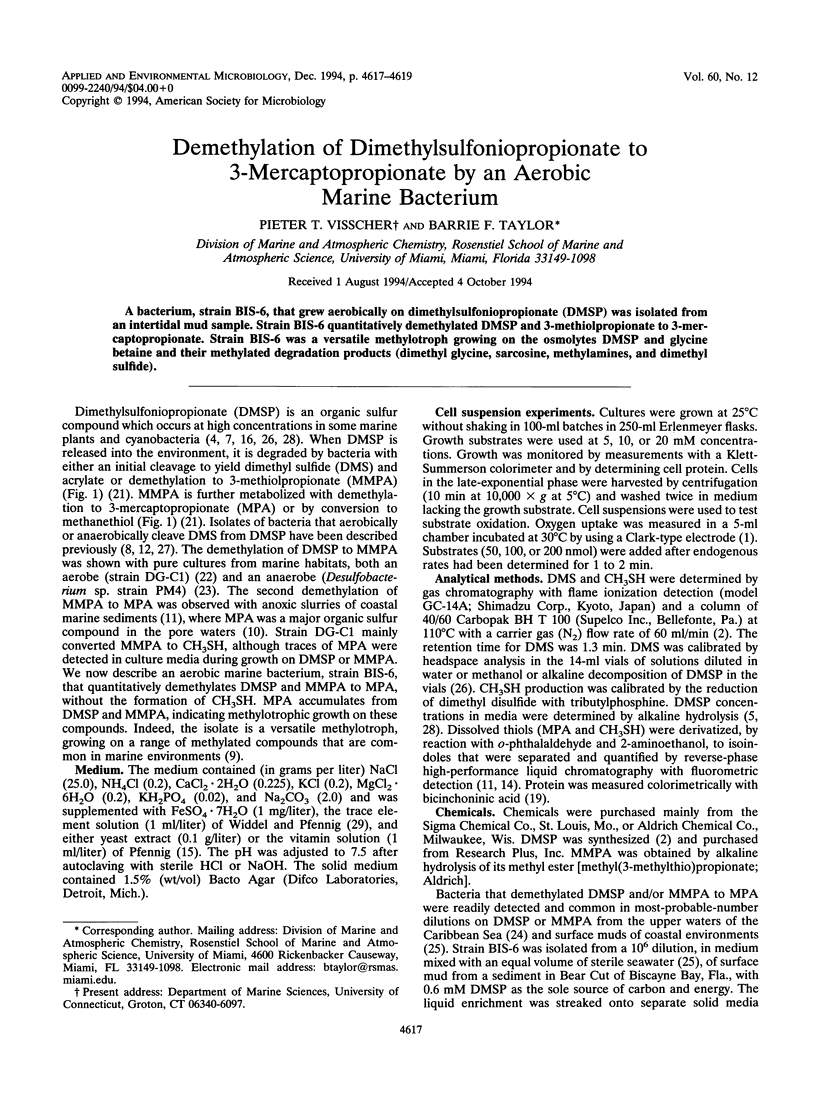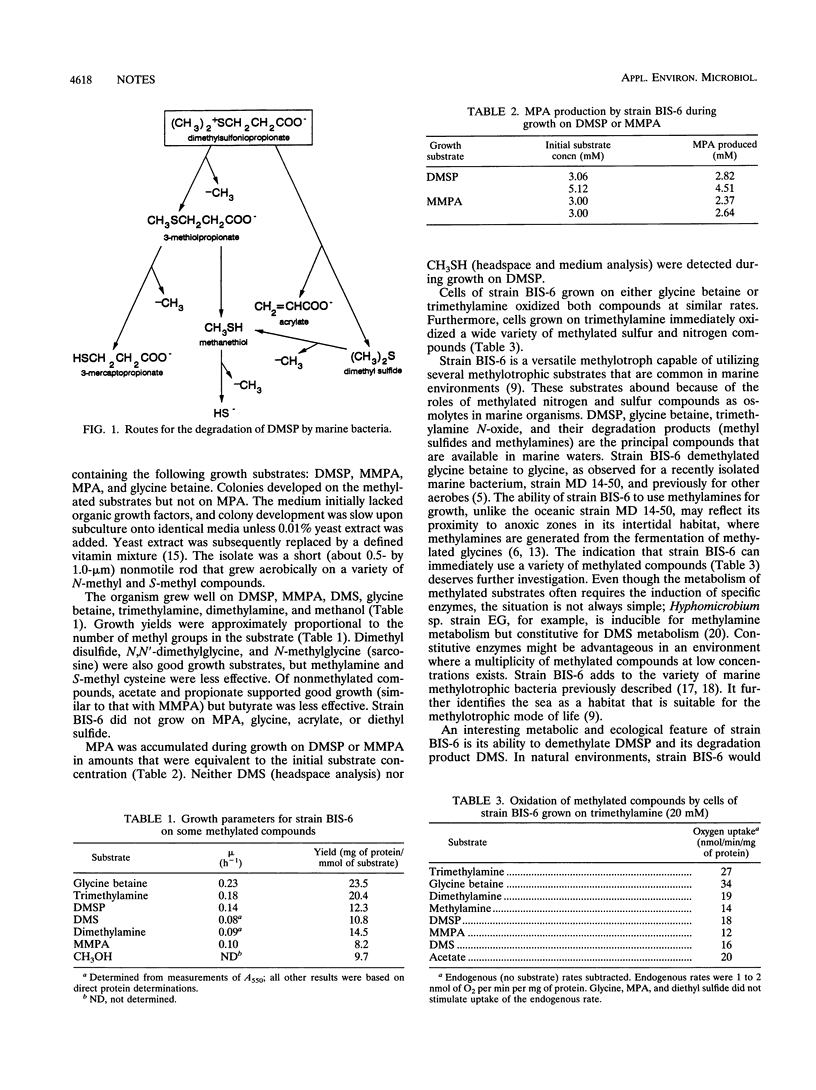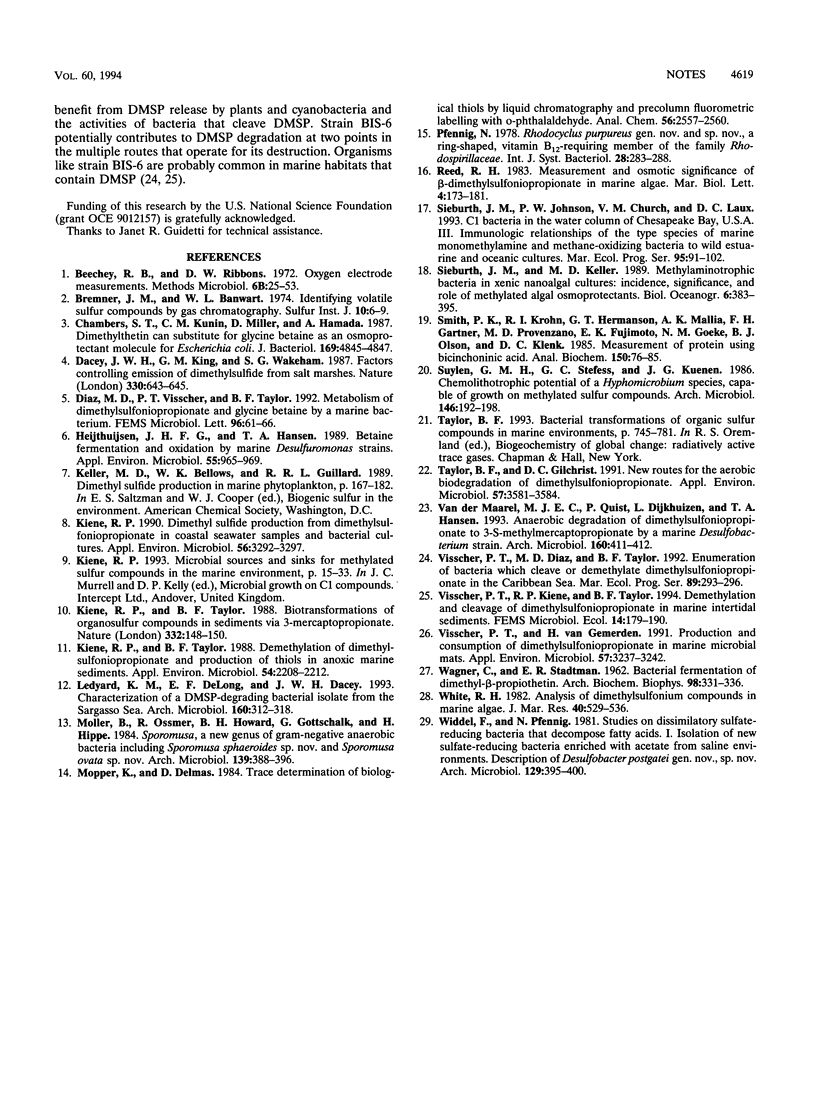Abstract
A bacterium, strain BIS-6, that grew aerobically on dimethylsulfoniopropionate (DMSP) was isolated from an intertidal mud sample. Strain BIS-6 quantitatively demethylated DMSP and 3-methiolpropionate to 3-mercaptopropionate. Strain BIS-6 was a versatile methylotroph growing on the osmolytes DMSP and glycine betaine and their methylated degradation products (dimethyl glycine, sarcosine, methylamines, and dimethyl sulfide.
Full text
PDF


Selected References
These references are in PubMed. This may not be the complete list of references from this article.
- Chambers S. T., Kunin C. M., Miller D., Hamada A. Dimethylthetin can substitute for glycine betaine as an osmoprotectant molecule for Escherichia coli. J Bacteriol. 1987 Oct;169(10):4845–4847. doi: 10.1128/jb.169.10.4845-4847.1987. [DOI] [PMC free article] [PubMed] [Google Scholar]
- Heijthuijsen J. H., Hansen T. A. Betaine fermentation and oxidation by marine desulfuromonas strains. Appl Environ Microbiol. 1989 Apr;55(4):965–969. doi: 10.1128/aem.55.4.965-969.1989. [DOI] [PMC free article] [PubMed] [Google Scholar]
- Kiene R. P. Dimethyl sulfide production from dimethylsulfoniopropionate in coastal seawater samples and bacterial cultures. Appl Environ Microbiol. 1990 Nov;56(11):3292–3297. doi: 10.1128/aem.56.11.3292-3297.1990. [DOI] [PMC free article] [PubMed] [Google Scholar]
- Kiene R. P., Taylor B. F. Demethylation of dimethylsulfoniopropionate and production of thiols in anoxic marine sediments. Appl Environ Microbiol. 1988 Sep;54(9):2208–2212. doi: 10.1128/aem.54.9.2208-2212.1988. [DOI] [PMC free article] [PubMed] [Google Scholar]
- Mopper K., Delmas D. Trace determination of biological thiols by liquid chromatography and precolumn fluorometric labeling with o-phthaladehyde. Anal Chem. 1984 Nov;56(13):2557–2560. doi: 10.1021/ac00277a064. [DOI] [PubMed] [Google Scholar]
- Smith P. K., Krohn R. I., Hermanson G. T., Mallia A. K., Gartner F. H., Provenzano M. D., Fujimoto E. K., Goeke N. M., Olson B. J., Klenk D. C. Measurement of protein using bicinchoninic acid. Anal Biochem. 1985 Oct;150(1):76–85. doi: 10.1016/0003-2697(85)90442-7. [DOI] [PubMed] [Google Scholar]
- Taylor B. F., Gilchrist D. C. New routes for aerobic biodegradation of dimethylsulfoniopropionate. Appl Environ Microbiol. 1991 Dec;57(12):3581–3584. doi: 10.1128/aem.57.12.3581-3584.1991. [DOI] [PMC free article] [PubMed] [Google Scholar]
- Visscher P. T., van Gemerden H. Production and consumption of dimethylsulfoniopropionate in marine microbial mats. Appl Environ Microbiol. 1991 Nov;57(11):3237–3242. doi: 10.1128/aem.57.11.3237-3242.1991. [DOI] [PMC free article] [PubMed] [Google Scholar]
- WAGNER C., STADTMAN E. R. Bacterial fermentation of dimethyl-beta-propiothetin. Arch Biochem Biophys. 1962 Aug;98:331–336. doi: 10.1016/0003-9861(62)90191-1. [DOI] [PubMed] [Google Scholar]
- Widdel F., Pfennig N. Studies on dissimilatory sulfate-reducing bacteria that decompose fatty acids. I. Isolation of new sulfate-reducing bacteria enriched with acetate from saline environments. Description of Desulfobacter postgatei gen. nov., sp. nov. Arch Microbiol. 1981 Jul;129(5):395–400. doi: 10.1007/BF00406470. [DOI] [PubMed] [Google Scholar]


